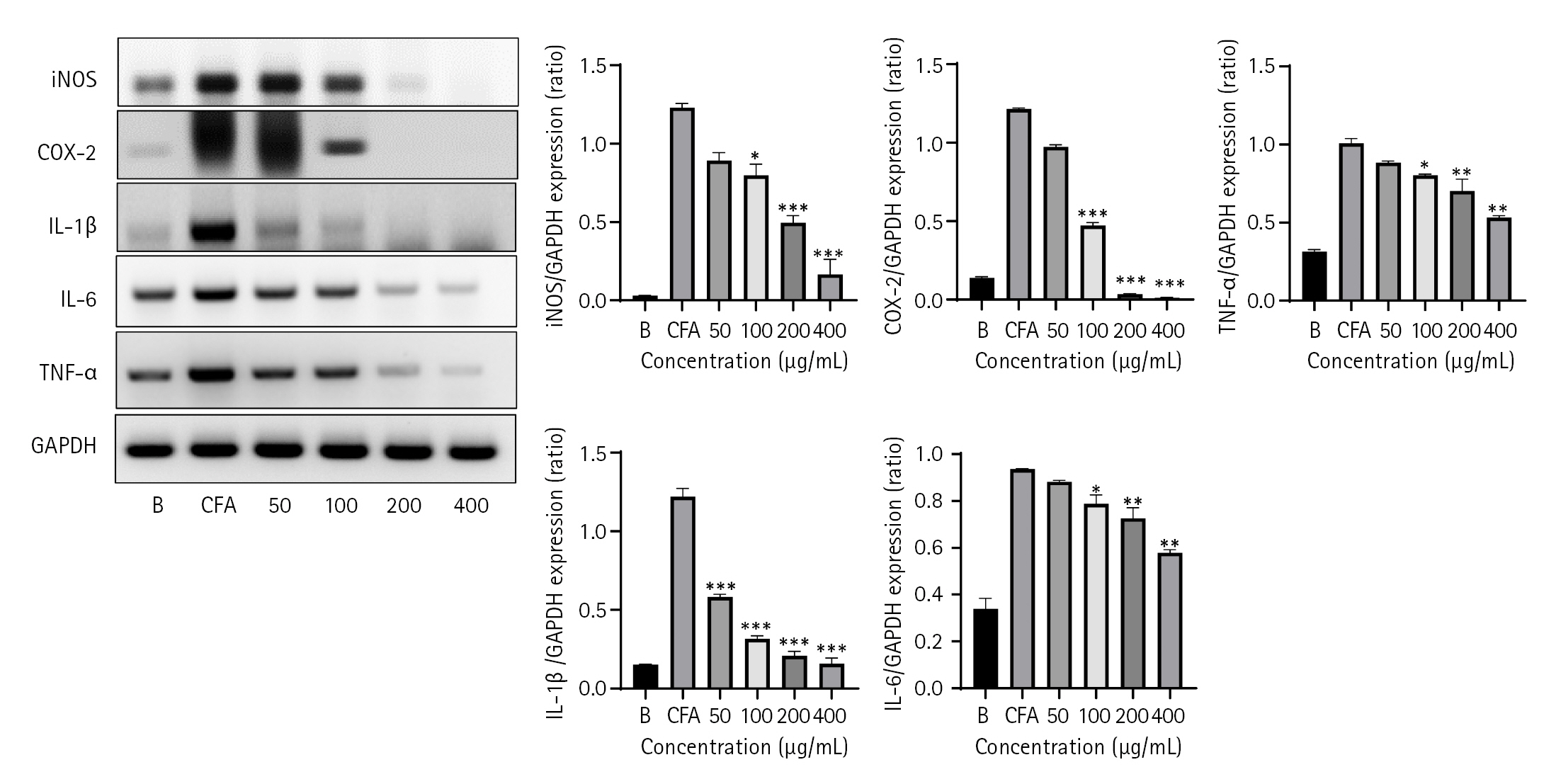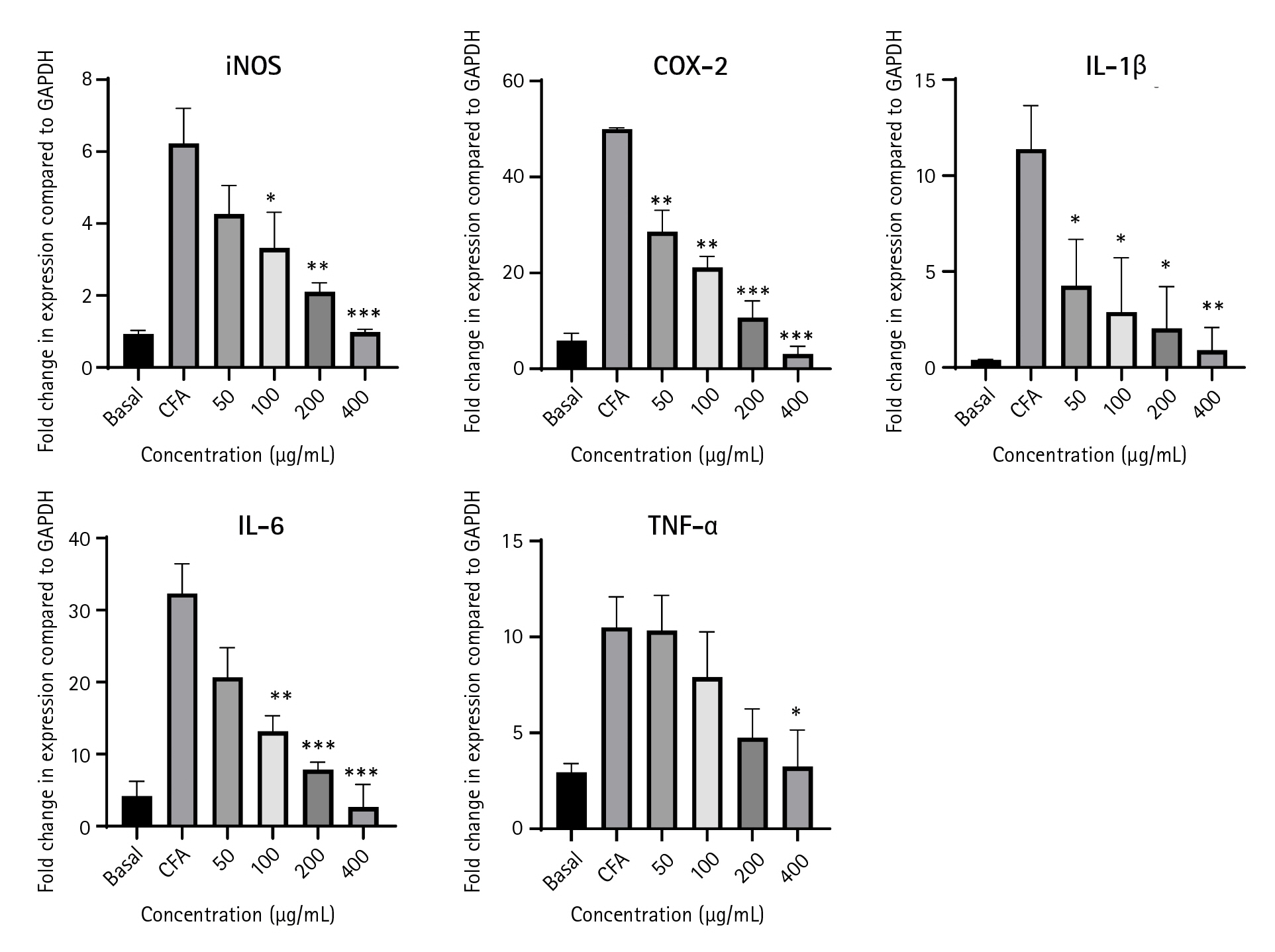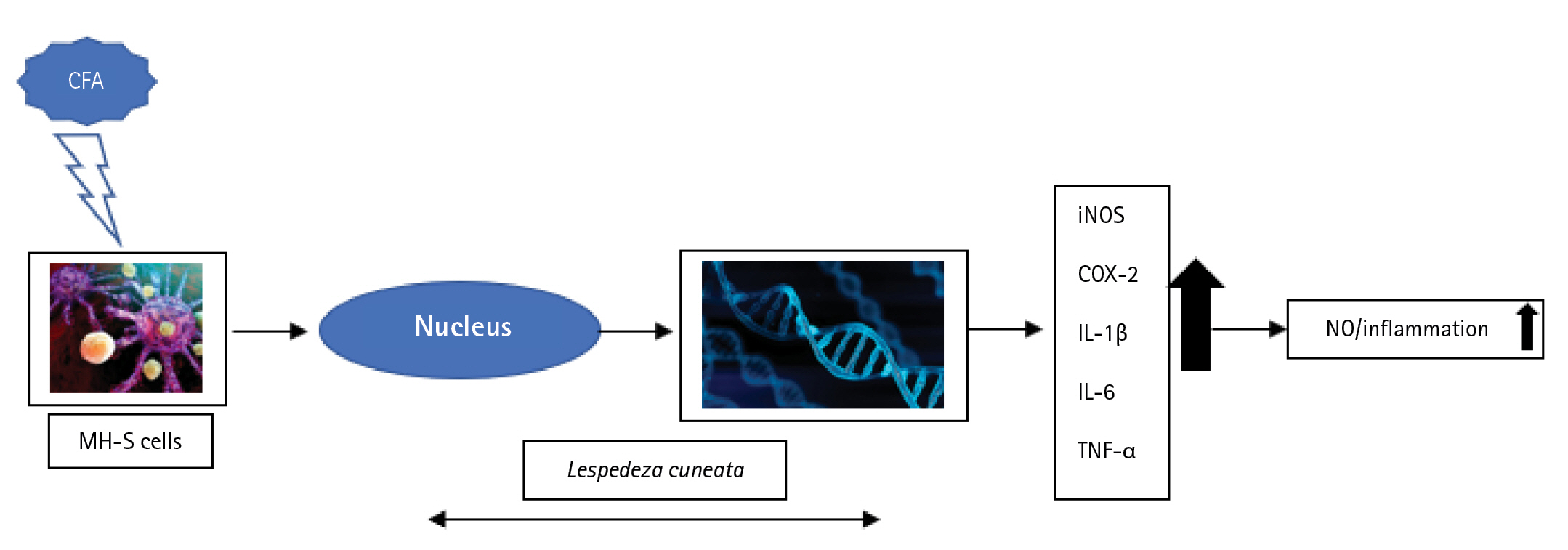2. Shi Q, Li L, Huo C, Zhang M, Wang Y. Study on natural medicinal chemistry and new drug development. Zhong Cao Yao 2010;41:1583-1589.
3. Deng F, Chang J, Zhang JS. New flavonoids and other constituents from Lespedeza cuneata. J Asian Nat Prod Res 2007;9:655-658.


4. Numata A, Hokimoto K, Yamaguchi H. C-Glycosylflavones in Lespedeza cuneata. Chem Pharm Bull 1980;28:964-965.

6. Ha SJ, Lee J, Song KM, Kim YH, Lee NH, Kim YE, Jung SK. Ultrasonicated Lespedeza cuneata extract prevents TNF-╬▒-induced early atherosclerosis in vitro and in vivo. Food Funct 2018;9:2090-2101.


7. Cho EJ, Lee SG, Kim DO. The effect of Lespedeza cuneata extract for antioxidative and whitening effect. J Life Resour Sci Res 2009;28:34-38.
8. Sanjeewa KKA, Jayawardena TU, Kim SY, Lee HG, Je JG, Jee Y, Jeon YJ. Sargassum horneri (Turner) inhibit urban particulate matter-induced inflammation in MH-S lung macrophages via blocking TLRs mediated NF-╬║B and MAPK activation. J Ethnopharmacol 2020;249:112363.


13. Yun HY, Dawson VL, Dawson TM. Neurobiology of nitric oxide. Crit Rev Neurobiol 1996;10:291-316.


14. Ignarro LJ. Nitric Oxide: Biology And Pathobiology. Academic Press, San Diego, 2000.
15. Mori M. Regulation of nitric oxide synthesis and apoptosis by arginase and arginine recycling. J Nutr 2007;137(6 Suppl 2):1616S-1620S.


16. Saba E, Lee YS, Yang WK, Lee YY, Kim M, Woo SM, Kim K, Kwon YS, Kim TH, Kwak D, Park YC, Shin HJ, Han CK, Oh JW, Lee YC, Kang HS, Rhee MH, Kim SH. Effects of a herbal formulation, KGC3P, and its individual component, nepetin, on coal fly dust-induced airway inflammation. Sci Rep 2020;10:14036.




17. Bradley JR. TNF-mediated inflammatory disease. J Pathol 2008;214:149-160.


18. Thomson AW, Lotze MT. The Cytokine Handbook, Two-Volume Set. 4th ed. Elsevier, Burlington, 2003.
19. Lee H, Jung JY, Hwangbo M, Ku SK, Kim YW, Jee SY. Anti-inflammatory effects of Lespedeza cuneata in vivo and in vitro. Korea J Herbol 2013;28:83-92.

20. Brand-Williams W, Cuvelier ME, Berset CL. Use of a free radical method to evaluate antioxidant activity. LWT Food Sci Technol 1995;28:25-30.

22. Kim HR, Son JH, Kim BR, Kim ID, Shin DH. Paper presented at 24th Asian-Pacific Weed Science Society Conference October 22-25, 2013. Bandung (Indonesia), 2013.
23. Mo S, Kim EY, Choi SH, Lee S, Lee S, Ahn JC. Sericea lespedeza (Lespedeza cuneata) whole plant extract enhances rat muscle mass and sperm production by increasing the activity of NO-cGMP pathway and serum testosterone. Trop J Pharm Res 2021;20:121-128.


25. Kim MS, Sharma BR, Rhyu DY. Beneficial effect of Lespedeza cuneata (G. Don) water extract on streptozotocin-induced type 1 diabetes and cytokine-induced beta-cell damage. Nat Prod Sci 2016;22:175-179.


26. Lee KS, Park SN. Cytoprotective effects and mechanisms of quercetin, quercitrin and avicularin isolated from Lespedeza cuneata G. Don against ROS-induced cellular damage. J Ind Eng Chem 2019;71:160-166.

27. Cho E, Ju H, Jeong C, Eom S, Heo H, Kim D. Effect of phenolic extract of dry leaves of Lespedeza cuneata G. Don on antioxidant capacity and tyrosinase inhibition. Korean J Hortic Sci Technol 2011;29:358-365.
28. Lee HJ, Lim GN, Park MA, Park SN. Antibacterial and antioxidative activity of Lespedeza cuneata G. Don extracts. Microbiol Biotechnol Lett 2011;39:63-69.
29. Floegel A, Kim DO, Chung SJ, Koo SI, Chun OK. Comparison of ABTS/DPPH assays to measure antioxidant capacity in popular antioxidant-rich US foods. J Food Compos Anal 2011;24:1043-1048.

31. Miller NJ, Rice-Evans CA. Factors influencing the antioxidant activity determined by the ABTS.+ radical cation assay. Free Radic Res 1997;26:195-199.


32. Kim DO, Chun OK, Kim YJ, Moon HY, Lee CY. Quantification of polyphenolics and their antioxidant capacity in fresh plums. J Agric Food Chem 2003;51:6509-6515.


34. Bruckdorfer R. The basics about nitric oxide. Mol Aspects Med 2005;26:3-31.


35. Cavaillon JM. Pro- versus anti-inflammatory cytokines: myth or reality. Cell Mol Biol (Noisy-le-grand) 2001;47:695-702.

37. Bai Y, Liu S, Jiang P, Zhou L, Li J, Tang C, Verma C, Mu Y, Beuerman RW, Pervushin K. Structure-dependent charge density as a determinant of antimicrobial activity of peptide analogues of defensin. Biochemistry 2009;48:7229-7239.


























 PDF Links
PDF Links PubReader
PubReader ePub Link
ePub Link Full text via DOI
Full text via DOI Download Citation
Download Citation Print
Print



